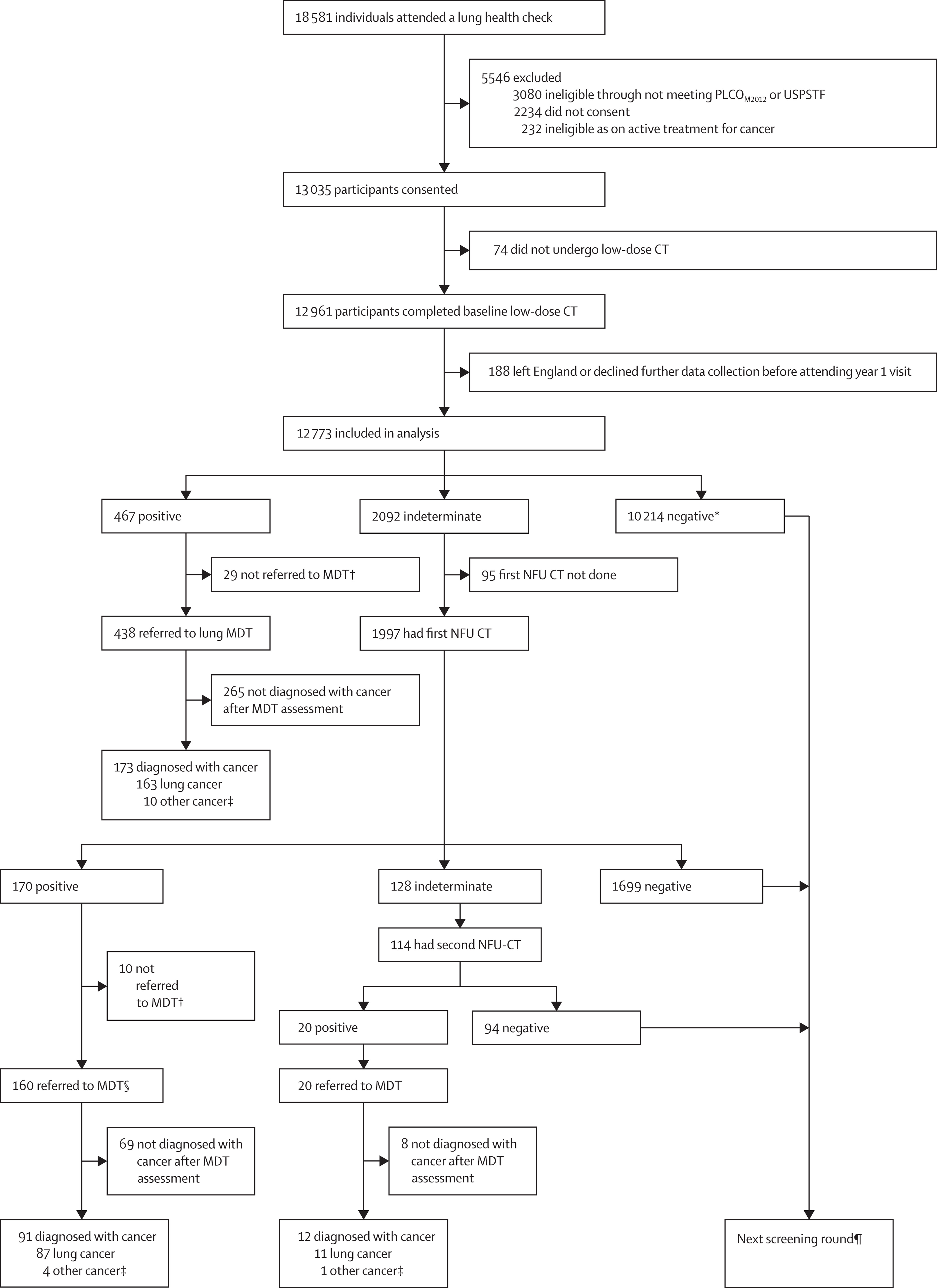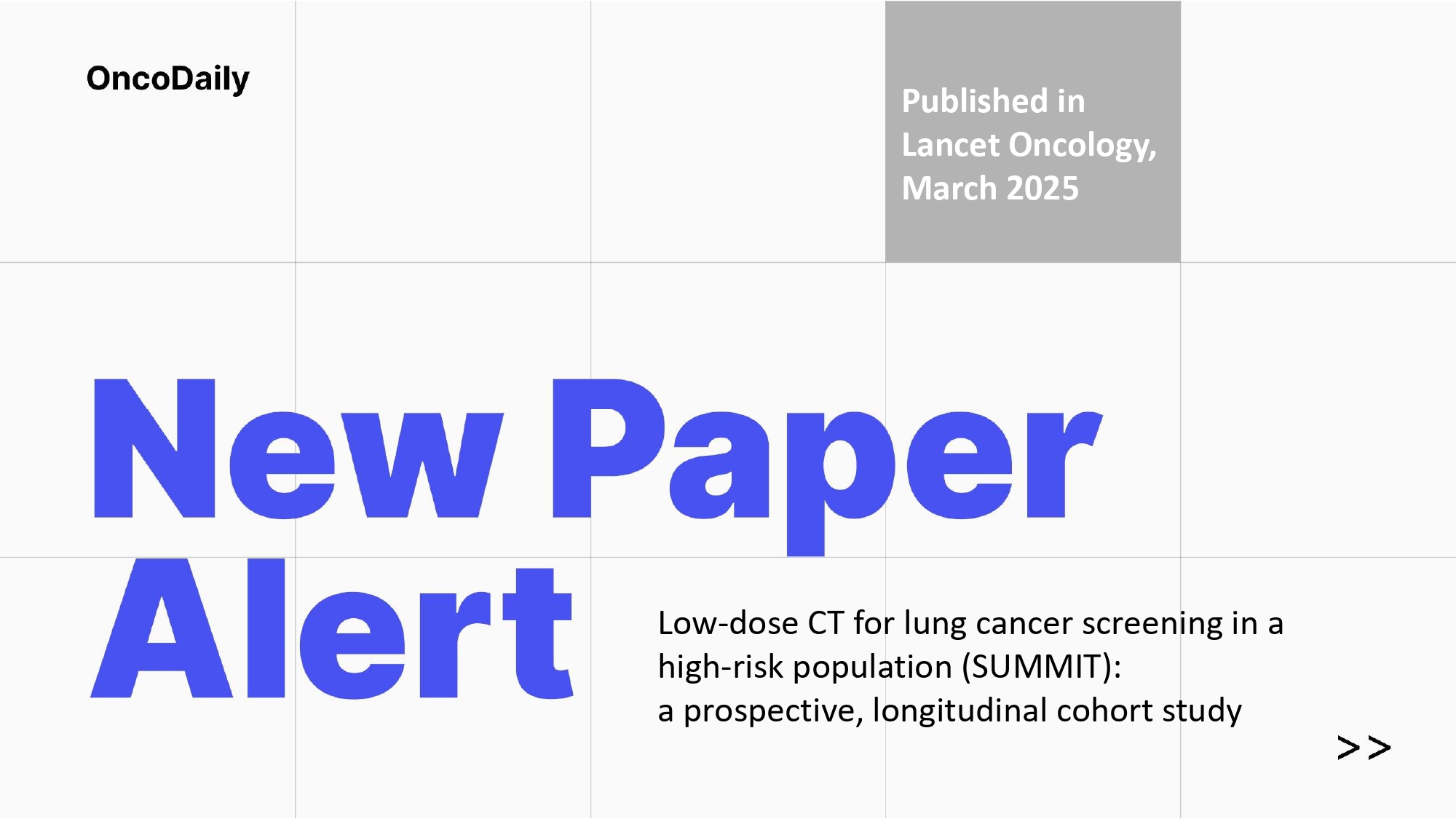The SUMMIT study provides compelling evidence for the feasibility and effectiveness of large-scale lung cancer screening using low-dose CT, particularly for high-risk individuals. The results highlight the potential of screening programs to detect lung cancer at an early stage, thereby enabling curative treatments that can significantly improve patient outcomes. The study also emphasizes the importance of addressing practical barriers to screening participation and improving the efficiency of follow-up procedures to maximize the impact of such programs on public health. While challenges such as false positives and benign resections remain, the findings offer valuable insights for developing and refining national lung cancer screening strategies. Ultimately, these results support the broader implementation of lung cancer screening as a critical tool in reducing lung cancer mortality.
Title:Low-dose CT for lung cancer screening in a high-risk population (SUMMIT): a prospective, longitudinal cohort study
Authors: Amyn Bhamani, PhD, Andrew Creamer, PhD, Priyam Verghese, BMBS, Ruth Prendecki, PhD, Carolyn Horst, PhD, Sophie Tisi, PhD, Helen Hall, PhD, Chuen Ryan Khaw, MBBS, Monica Mullin, MD, John McCabe, MSc, Kylie Gyertson, MA, Vicky Bowyer, MSc, Dominique Arancon, BS, Jeannie Eng, BSc, Fanta Bojang, PhD, Claire Levermore, Anne-Marie Hacker, MSc, Esther Arthur-Darkwa, BSc, Laura Farrelly, MSc, Anant Patel, MBBS, Sara Lock, MA, Alan Shaw, MSc, Rajesh Banka, MD, Angshu Bhowmik, MD, Ugo Ekeowa, PhD, Zaheer Mangera, MA, Christopher Valerio, MBChB, William M Ricketts, MBBS, Ali Mohammed, MBChB, Terry O’Shaughnessy, MBBChir, Prof Neal Navani, PhD, Samantha L Quaife, PhD, Arjun Nair, MD, Prof Anand Devaraj, MD, SUMMIT consortium, Jennifer L Dickson, PhD, Prof Allan Hackshaw, MSc, Prof Sam M Janes, PhD
Published in Lancet oncology, March 2025
Background
Lung cancer remains the leading cause of cancer-related deaths worldwide, with a majority of cases diagnosed at later stages when curative treatment options are limited. Early detection through screening is essential to improve survival rates, especially among high-risk populations such as heavy smokers. In this context, the SUMMIT study, conducted between April 8, 2019, and May 14, 2021, aimed to evaluate the effectiveness of low-dose computed tomography (CT) screening for lung cancer detection. This study was designed to assess the prevalence of lung cancer, the accuracy of low-dose CT scans, and the outcomes of patients diagnosed with early-stage disease.
Methods
The SUMMIT study was a large-scale lung cancer screening initiative conducted in northeast and central London. The study included 12,773 participants who were high-risk ever-smokers, all of whom underwent baseline low-dose CT screening. Eligible participants were invited to participate, and the study analyzed the incidence of lung cancer detected through this screening process. Follow-up imaging and assessments were done at 3-month and 6-month intervals for those with indeterminate findings. The study also collected data on other intrathoracic malignancies, benign resected lesions, and the outcomes of surgical treatments.
Study Design of SUMMIT study
The SUMMIT study was designed to assess lung cancer prevalence in a high-risk cohort. Participants were selected based on their smoking history, and those with a history of heavy smoking were given priority for screening. The baseline screening was performed using low-dose CT, which is known for its ability to detect early-stage lung cancer with high sensitivity. The study involved various stages of follow-up, including a three-month interval CT scan for those with indeterminate nodules. A multidisciplinary team, including specialists in lung cancer, managed referrals for participants with suspicious findings.
Results of SUMMIT study
From April 8, 2019, to May 14, 2021, a total of 18,581 individuals attended a lung health check, with 13,035 (85.4%) of 15,269 eligible individuals choosing to participate. Ultimately, 12,773 participants were included in the analysis. Among these, 57.6% were male, 42.4% were female, and 83.5% were White.
Of the participants, 261 (2.0%) were diagnosed with lung cancer after a positive baseline screen, including 163 (1.3%) with screen-detected lung cancer and 98 (0.8%) with delayed screen-detected lung cancer. A total of 276 (2.2%) participants were diagnosed with any intrathoracic malignancy. The number needed to screen to detect one lung cancer was 49.0 (95% CI 43.4–55.4), and to detect any intrathoracic malignancy was 46.0 (95% CI 41.2–52.2).
The study showed a high sensitivity of 97.0% (95% CI 95.0–99.1) for detecting lung cancer at 12 months. The specificity was 95.2% (95% CI 94.8–95.6), with a false-positive rate of 4.8%. The positive predictive value was 30.3% (27.3–33.4), and the negative predictive value was 99.9% (99.9–100.0).
A significant number of participants, 2092 (16.4%), had indeterminate pulmonary nodules requiring follow-up imaging. Among those who underwent 3-month follow-up CT scans, 170 (8.5%) had positive results, and 160 (94.1%) of these were referred to a lung cancer multidisciplinary team.

Key Findings
- High Sensitivity and Specificity: The screening protocol demonstrated a high sensitivity of 97.0% and a specificity of 95.2% at the 12-month mark, indicating that low-dose CT is an effective tool for lung cancer detection.
- Early Detection of Lung Cancer: The majority of lung cancers diagnosed were in the early stages, with 79.3% of screen-detected lung cancers diagnosed at stages I or II, which allows for treatment with curative intent.
- Low False-Positive Rate: The study reported a false-positive rate of 4.8%, which is relatively low and suggests that the screening method is effective at identifying true positives while minimizing unnecessary procedures.
- Actionable Findings in 5.7% of Participants: 723 participants had actionable findings from baseline CT scans, with the majority referred to multidisciplinary teams for further assessment and treatment.
- Surgical Resection as Primary Treatment: Among participants diagnosed with screen-detected lung cancer, 77% underwent surgical resection, highlighting the effectiveness of early detection for enabling curative treatment.
- Benign Resection Rate: The rate of benign resections was 10%, which is within the expected range for lung cancer screening studies, particularly when considering the high prevalence of mycobacterial diseases in the area.
Key Takeaway Messages
This study demonstrates that low-dose CT screening is an effective method for detecting lung cancer at an early stage, which significantly improves the chances for curative treatment.Early detection through screening is crucial for improving outcomes, as the majority of lung cancers in the study were diagnosed at stages I or II, which are more amenable to curative treatments like surgery.
- Feasibility of Large-Scale Screening: The study shows that large-scale lung cancer screening programs can be successfully implemented, with high participation rates and robust data collection, making them feasible for broader public health initiatives.
- Need for Follow-up and Multidisciplinary Care: The high referral rate to multidisciplinary teams highlights the importance of collaboration in lung cancer management, ensuring that participants receive comprehensive care following detection.
- Consideration of False Positives: Although the false-positive rate was relatively low, the findings underscore the need to balance sensitivity and specificity in screening protocols to minimize unnecessary follow-up procedures and anxiety for participants.
You can read the full article here
Written by Sona Karamyan, MD
